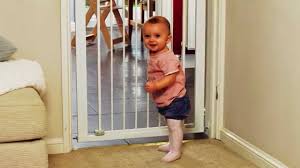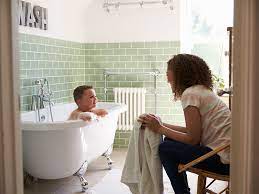Baby proofing your home
Many new parents are surprised to learn that the most common place for babies and infants to be injured is in and around the home.
Babies can suffer serious injuries, illness and even death because they don’t know how to identify or understand dangerous situations, and they don’t have the physical skills needed to quickly get out of danger. As a parent, it’s recommended that you get down on your hands and knees and conduct—from your baby’s perspective—a thorough inspection of your home for hazards, before your child is old enough to experience these hazards themselves. Crawling around on your hands and knees may seem OTT but you may be surprised but what potentially dangerous items are within a baby’s reach.
Understand and remove hazards
Falls
Children can suffer injuries after falling from furniture and play equipment, through windows or down stairs. Eliminate access to any item of furniture or equipment, window or staircase using gates, barriers, locks or moving items to another locked room for a while.
Choking
Babies and toddlers often place things in their mouths. Small objects, such as broken pieces of toys, pieces of fabric, coins, button batteries, nuts and lollies, can easily lodge in their throat and block their airway. Using a robot vaccum can be used daily to minimise the time you spend cleaning and will get under all the furniture for you picking up any small items.

Strangulation
Children can become tangled in ribbons, ties, or blind and curtain cords. These can quickly wrap around their throat and strangle them. Ensure that all cords, ties and cords are secured away from the reach of baby.
Suffocation
When babies have their faces trapped against bedding, fabric, pillows, mattresses or soft toys, they may not be able to roll away and can quickly suffocate. Never use pillows, folded quilts, bumpers or toys in a baby bed. Do not add extra mattresses, foam or cushioning to baby beds that was not provided by the manufacturer.
Crushing
Babies and toddlers climbing onto or holding unstable furniture can quickly pull it down on themselves. They can also crush their fingers in moving parts on items such as doors, drawers, prams, strollers, high chairs, portable cots and playpens. Always ensure that furniture is bolted to the wall and any heavy items are barricaded off
Trapping
Gaps in equipment that are 30 mm to 50 mm wide can trap your baby’s legs or arms. Gaps between 95 mm and 230 mm can trap your baby’s head by allowing their body, but not their head, to fit through the space. This can strangle them.
Cuts
Sharp edges on toys, equipment and benches can cause cuts. Any folding frames and moving parts need a safe space between moving parts (at least 5 mm to 12 mm), so they don’t act like scissors on your children’s fingertips.
Drowning
Babies and toddlers can quickly drown in even very small amounts of water. Always empty buckets, nappy buckets, basins and bowls of water after use, or place them out of reach. Install four sided fencing, and self-closing, self-latching gates around pools, as required by law. Never leave your baby or toddler alone in a bath, bath aid, paddle pool or basin of water—even for the shortest time. Remember, aquatic toys, flotation aids and bath aids are not safety devices. There is no substitute for good, close (at arm’s length), competent adult supervision around water. You may also want to consider taking a course on water safety so you are better prepared in the event of an emergency.

Poisoning
- Place poisons in a secure place, such as an out-of-reach cupboard that is at least 1.5 metres above floor level.
- Always choose medical and cleaning products with child-resistant packaging or closures. Place child-resistant locks on cupboards, garden sheds and garage doors.
- Use door barriers and door knob covers to prevent access to rooms where poisons are kept.
Burns, scalds and electrocution
- Keep your children away from hot food and drinks, electrical appliances, barbecues and treadmills—these products have caused serious burns and/or electrocution.
- Put matches and lighters out of reach and install stove barriers, hotplate guards, power point covers, hot tap safety covers and hot water temperature control valves.
Never let your children play in the kitchen while you’re preparing meals. Burns and scalds have occurred after children have pulled on electrical appliance cords for things like cookers, kettles or fry pans. You should also install and maintain smoke alarms, place a fire blanket and extinguisher in the kitchen, develop a home fire escape plan and practise it regularly.
Recommendations:
Only choose products that are for your baby’s age and size;
Always, always read and follow the manufacturer’s instructions for assembly and use;
Stay within sight and reach of babies and toddlers—don’t leave them in the care of other children;
Regularly check products to ensure latches, locks, brakes and frames work—make sure there are no torn fabrics or accessible small parts that may cause choking, or gaps that may trap your baby or allow your baby to fall through;
If you find a baby product that is damaged, seek out an approved repairer recommended by the manufacturer – never attempt to repair your baby products yourself;
Dispose of damaged children’s products that can’t be repaired;
Keep a well-stocked first aid kit in your home and take a first aid course before your baby arrives.
